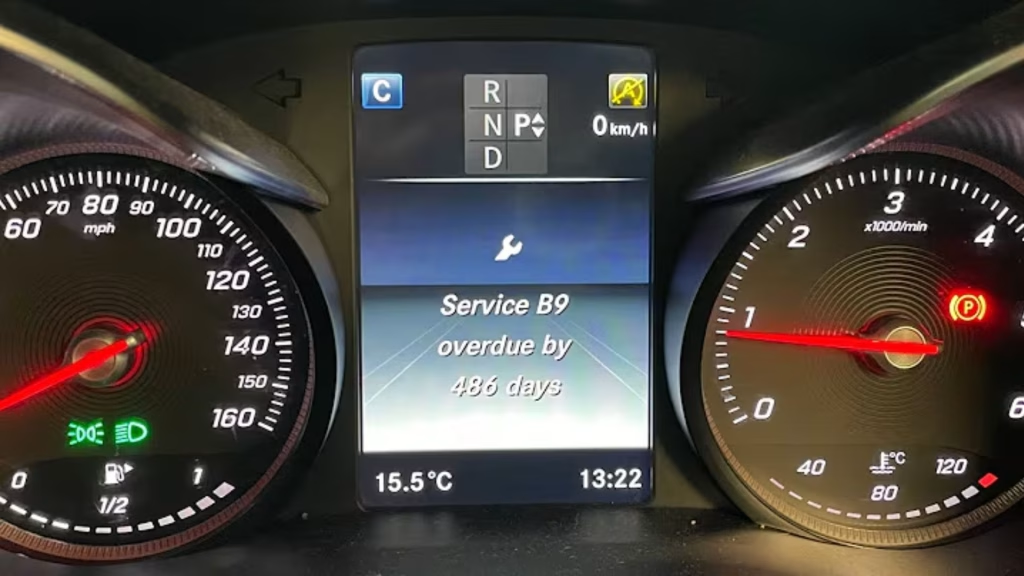
The Mercedes B9 Service ensure your vehicle continues to perform at its best. Typically required between 80,000 to 120,000 miles, the B9 service includes essential tasks such as oil and filter replacements, brake fluid change, spark plug inspection, and transmission fluid maintenance. Ignoring this service can lead to reduced engine efficiency, transmission issues, and costly repairs.
The cost for this service generally falls between $700 and $1,500, depending on factors like car model, location, and the service provider. By staying on top of your B9 service schedule, you can prevent major problems and keep your Mercedes running smoothly for years to come.
Key Takeaways
- What is B9 Service? Oil/filter changes, brake fluid replacement, spark plug inspection, air filter replacement, and transmission fluid maintenance.
- Why is it Important? Prevents engine wear, transmission issues, and costly repairs. Ensures vehicle performance, safety, and longevity.
- When to Schedule? Around 80,000 to 120,000 miles, or when the service reminder appears.
- Cost & Duration:
Cost: $700–$1,500.
Time: 2–5 hours. - Where to Get It Done? Mercedes-authorized service centers or independent specialists using genuine parts.
- Benefits: Prevents major issues, boosts vehicle efficiency, and prolongs the lifespan of key components.
Mercedes B9 Service Meaning
The B9 service is part of Mercedes-Benz’s routine maintenance schedule, ensuring that critical vehicle components like the fuel injection system are in top condition. Unlike basic oil changes, the B9 service involves replacing fluids, checking the brakes, and inspecting the transmission system to prevent potential performance issues.
The B9 service reminder typically appears when your vehicle has traveled between 80,000 to 120,000 miles. At this stage, essential parts like the engine oil, filters, and transmission fluid require attention to keep your car running smoothly. Ignoring the B9 service could lead to reduced engine efficiency, transmission issues, and costly repairs. Additionally, situations like poor fuel quality can exacerbate these problems, making routine maintenance even more necessary.
What’s Included in a Mercedes B9 Service Checklist?
When your Mercedes-Benz is due for a B9 service, it means several key components need attention to keep your vehicle running at peak performance. This isn’t just a routine check-up—it’s a comprehensive maintenance package that ensures everything from your engine to your transmission is in top shape.
Here’s what’s included in a Mercedes B9 service checklist:
| Service Item | Purpose |
| Oil and Filter Replacement | Keeps the engine lubricated, prevents wear and tear |
| Brake Fluid Change | Maintains braking efficiency and safety |
| Spark Plug Replacement | Ensures smooth ignition and fuel efficiency |
| Air Filter Replacement | Improves engine performance and fuel economy |
| Wiper Blade Inspection/Replacement | Enhances visibility in rain or snow |
| Automatic Transmission Fluid (ATF) Replacement | Prevents gear slipping and overheating |
This table provides a clear and structured checklist while making it easy for readers to understand the importance of each service item. Let me know if you need any refinements!
Mercedes B9 Service Price: Cost Breakdown & Factors
The cost of a Mercedes B9 service isn’t fixed—it can range from $700 to $1,500, depending on several key factors.
What Affects the Cost?
- Car Model – Newer models with advanced tech cost more to service than older ones.
- Labor Costs – Dealership service centers often charge higher labor rates compared to independent mechanics.
- Location – Service prices vary by region—expect to pay more in cities or high-cost living areas.
Dealership vs. Independent Repair Shops: Which One Saves You More?
- Dealerships: Offer Mercedes-certified service, access to OEM parts, and software updates—but they charge a premium.
- Independent Shops: Usually more affordable, but ensure they use genuine Mercedes parts to maintain performance.
Want to save money? Visit Arnone’s Car Care to get the best and most affordable services for your Mercedes. Book your appointment today and experience exceptional service that keeps your car running at its peak!
How Often Should You Get a B9 Service?
There’s no fixed date when a B9 service is required, but generally, Mercedes-Benz recommends this service once your car reaches 80,000 to 120,000 miles. The actual timing depends on various factors, including:
- Your driving habits – Frequent stop-and-go traffic, aggressive driving, or long-distance travel can accelerate wear and tear.
- Environmental conditions – Hot or cold climates, dusty roads, and frequent highway driving can impact service needs.
- Mileage & usage – High-mileage vehicles need more frequent servicing compared to those driven occasionally.
Most modern Mercedes models are equipped with an advanced Service Reminder System that will notify you two months in advance when your next service is due. The system analyzes your driving patterns and engine performance to determine the exact timing of maintenance.
How Long Does a Mercedes B9 Service Take?
Wondering how long you’ll be without your car? A Mercedes B9 service typically takes anywhere from 2 to 5 hours, depending on a few factors.
What Affects Service Time?
- Extent of Repairs – If only fluids and filters need replacing, it could be a quick job. But if mechanics spot additional issues, repairs may take longer.
- Technician Availability – A busy dealership or service center might have longer wait times, while independent shops may get your car in and out faster.
- Car Model & Condition – Older or high-mileage models may require more thorough inspections, adding to the total service time.
If you want a faster turnaround, consider booking your service appointment in advance and visiting a Mercedes-certified mechanic for efficient repairs.
Understanding the B9 Service Dashboard Warning Light
When your Mercedes needs a B9 service, a yellow or red service indicator may appear on your dashboard. This is your car’s way of reminding you to book a maintenance appointment before minor issues turn into major problems. For example, a delay in inspecting engine oil leaks or addressing transmission concerns could lead to expensive repairs.

If you notice any unusual noises, reduced fuel efficiency, or a sluggish transmission, it might also be time to schedule your B9 service sooner rather than later.
Mercedes B9 Service Reset: How to Clear the Service Indicator
Once your B9 service is complete, you may still see the service reminder light on your dashboard. This needs to be reset manually, but it’s important to only reset it after the required maintenance has been performed.
How to Reset the B9 Service Indicator?
- Turn on the Ignition – Set your key or push-start button to position two (without starting the engine).
- Access the Trip Menu – Use the steering wheel buttons to select the trip menu on the instrument cluster.
- Enter the Workshop Menu – Hold the Return button, then quickly press and hold the Scroll button for about 5 seconds.
- Select Assist Plus – Scroll to Assist Plus > Full Service > Confirm Service.
- Confirm Oil Grade – If prompted, select the correct oil type that was used during the service.
- Reset the Service Light – Once confirmed, the service indicator will reset, and the warning light will disappear.
If the reset doesn’t work, double-check that the service was completed correctly, and try again. If issues persist, a Mercedes technician can reset it using a diagnostic scanner.
Warning Signs That Your Mercedes Needs B9 Service
Your Mercedes-Benz has a high-tech system that alerts you when it’s time for service, but sometimes, problems arise before the B9 indicator appears. Watch out for these warning signs—if you notice any of them, it’s time to schedule a service appointment ASAP.
1. Engine Making Unusual Noises
A knocking, ticking, or rattling engine can be a sign of low oil levels, dirty filters, or worn-out spark plugs—all of which are addressed in the B9 service.

2. Excessive Exhaust Emissions
If you see dark smoke coming from the exhaust, your engine might be burning too much oil or fuel, indicating a problem with the air filter or spark plugs.
3. Increased Fuel Consumption
A sudden drop in fuel efficiency means your car is working harder than it should. This could be due to clogged air filters, aging spark plugs, or low-quality oil—all of which are replaced during B9 service.
4. Slower Acceleration or Transmission Slipping
If your Mercedes feels sluggish or struggles to shift gears smoothly, it might be due to old transmission fluid or other drivetrain issues. A B9 service includes transmission fluid replacement, which can fix this issue.
Ignoring these signs can lead to bigger, more expensive repairs, so don’t wait—get your Mercedes serviced as soon as you notice something off.
Final Thoughts
Keeping up with your Mercedes B9 service is essential for maintaining performance, safety, and longevity. This service includes oil changes, brake fluid replacement, spark plug checks, and transmission maintenance, all of which help prevent costly repairs down the road.
While some minor tasks can be done at home, a certified Mercedes technician ensures the job is done right with genuine parts and expert diagnostics. If you notice warning signs like reduced fuel efficiency, rough shifting, or engine noise, don’t delay, schedule your B9 service to keep your Mercedes running at its best.
FAQs
Q. Can I skip a Mercedes B9 service if my car seems fine?
No, skipping B9 service can lead to engine wear, transmission issues, and costly repairs over time. Preventative maintenance is always better.
Q. How much does a Mercedes B9 service cost?
The cost ranges from $700 to $1,500, depending on your model, location, and service provider. Dealerships typically charge more than independent shops.
Q. Can I reset the B9 service light myself?
Yes, you can reset it using the trip menu and workshop settings, but only after the required maintenance is completed. Resetting without servicing can lead to performance issues.
Q. How do I know when my Mercedes needs a B9 service?
The dashboard warning light will notify you when it’s time for service, typically around 80,000 to 120,000 miles. Other signs include poor fuel economy and rough shifting.






